New publications
Migraine diet
Last reviewed: 29.06.2025

All iLive content is medically reviewed or fact checked to ensure as much factual accuracy as possible.
We have strict sourcing guidelines and only link to reputable media sites, academic research institutions and, whenever possible, medically peer reviewed studies. Note that the numbers in parentheses ([1], [2], etc.) are clickable links to these studies.
If you feel that any of our content is inaccurate, out-of-date, or otherwise questionable, please select it and press Ctrl + Enter.

Expanding the diet at the expense of plant fiber helps to reduce migraine attacks. This was stated by representatives of the Chinese University of Jinan.
Migraine is a common neurological pathology, which is characterized by severe attack-like pain in the head. The incidence rate of the population averages 16-17%, which is quite high. An important factor in the development of the disease is heredity and ecology, although experts also talk about other ubiquitous causes - in particular, improper nutrition, alcohol consumption, stressful influences, etc. The influence of several factors at once determines the intensity and duration of pain attacks.
Scientists analyzed the possible relationship between dietary intake, the presence of plant fibers in it, and the development of migraine. A cross-sectional research work was conducted, which involved about 13 thousand volunteers, the overall prevalence of migraine among whom reached almost 20%. During the study, experts found a clear relationship between regular fiber intake and recurrent migraine attacks. Increasing the proportion of plant foods in the diet by every 10 g daily helped to reduce the intensity of headaches by more than 10%.
Vegetables and fruits, beans and cereals contain the greatest amount of plant fibers. The benefits of such a diet are obvious: it improves the function of the digestive system, normalizes blood glucose, reduces cholesterol, stabilizes the balance of hunger and satiety. In addition, plant fiber has a positive effect on the quality of intestinal microflora.
Dietary fibers are specific substances of plant nature, which are not broken down and digested by human digestive enzymes, but are used as food by the bacterial flora inhabiting the intestines. Therefore, fiber is classified as a prebiotic - components that contribute to the normalization of the body's microflora and maintenance of its bioactivity.
Maximum fiber content is found in fruits and vegetables with peel, seeds and nuts, whole grain products.
Specialists advise to include five vegetables and two fruits in your diet every day, preferably in raw form. Bread and pasta should be replaced with whole-grain versions, and potatoes should be baked and eaten with the skin on. As snacks, it is better to use nuts or fruit rather than sandwiches and cookies, and beans, chickpeas, and seeds should be regularly added to salads.
You can also take special fiber supplements. To preserve dietary fiber when cooking, vegetables should not be boiled for too long.
To optimize the action of the herbal product, it is important to consume enough drinking water - at least one and a half to two liters.
Information published on pages of the Internet editiontitle="Frontiers | The association between dietary fiber intake and severe headaches or migraine in US adults">
